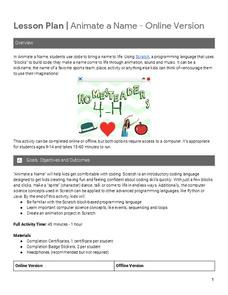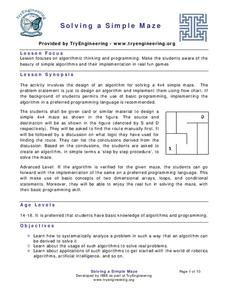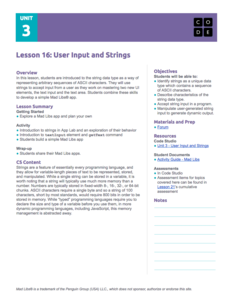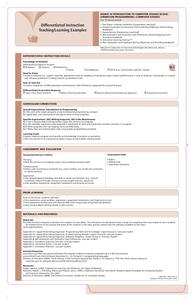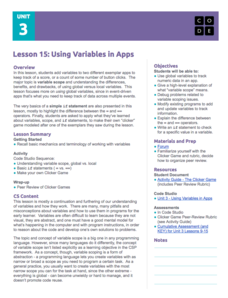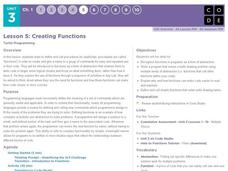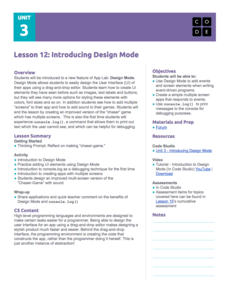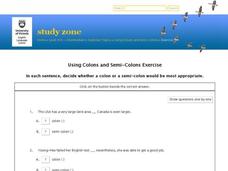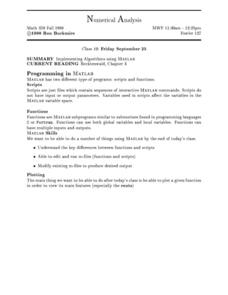Programming Languages Teacher Resources
Find Programming Languages lesson plans and worksheets
Showing 277 resources
Google
Animate a Name
What's in a name? Pupils use the Scratch code blocks to animate letters in a name. They learn about events, sequencing, and loops in computer science by taking part in the project.
TryEngineering
Solving a Simple Maze
Solve a maze ... from a robot's point of view. In the instructional activity, your scholars build a small, simple maze from cardboard and then find a route from the start point to the finish point. They write an algorithmic process that...
Curated OER
Solving a Simple Maze
It is a-maze-ing how lost one can get. Teams reconstruct a simple maze and solve it. Participants create an algorithm that a robot would follow in order to solve the maze as well. The activity includes an extension directing pupils to...
Code.org
Introduction to Arrays
How can you store lists in a computer program? The 16th installment of a 21-part unit introduces arrays as a way to store lists within a variable. Individuals program a list of their favorite things—adding interest to the activity.
Code.org
User Input and Strings
Pupils learn to apply strings in computer science. They master two new user interface elements and also use string type data to represent ASCII characters. Finally, individuals create an app for Mad Libs in the eighth lesson of the series.
Khan Academy
What is Programming?, Intro to JS: Drawing and Animation, Computer Programming
It's time to unleash your class's inner geek. This introductory video starts one on a path of learning to code. It is the first in a series of videos that help you learn the fundamentals of coding. The series focuses on producing art and...
Ontario
Animation Programming—Computer Studies
Introduce high schoolers interested in animation programming to fundamental programming concepts so that they can plan and write simple programs.
Code.org
Using Variables in Apps
Investigate the benefits of using global variables. The seventh installment of a 21-part unit continues the study of variables from the previous lesson. Young computer scientists modify two existing apps by adding variables and learn how...
Crash Course
Programming Basics—Statements and Functions: Crash Course Computer Science #12
Include an informative video on programming as part of your computer science instruction. The 12th installment in the series teaches about statements and functions required to write code. Individuals learn about the IF, FOR, and...
Code.org
Creating Functions
Quit repeating yourself ... you can make this simpler! Rather than repeating the same set of code over and over, class members learn to build and call functions in a series of challenges in App Lab. In the end, they combine...
Google
Adventure on the High Seas
Ahoy there! A fun computer science lesson challenges pupils to write a program that creates an ocean wave. They then develop stories to accompany their projects. All of this takes place within the Scratch coding program.
Code.org
Looping and Random Numbers
Repetition, repetition, repetition. Get your class to efficiently repeat a section of code over and over again by introducing looping. Class members learn looping to quickly recreate objects they want to appear more than once in their...
Curated OER
Grammar - Revise Your Symbols
Explore the different symbols of grammar. Middle schoolers write two sentences using different symbols, including asterisks, apostrophes, and ellipses. They also read and answer guided questions.
Code.org
Introducing Design Mode
Move beyond buttons when designing user interfaces. In the fourth installment of a 21-part unit, young computer scientists learn to apply design mode, which gives users options for colors, fonts, etc. They learn to incorporate these...
Google
Create Your Own Google Logo
You'll have oodles of Google Doodles. Scholars create their own Google logos using the Scratch coding program. After watching videos on how to add blocks of code in Scratch, they use their newfound knowledge to design a logo based on a...
Curated OER
Intelligence in the Internet Age
Does technology affect our intelligence? Stefanie Olsen's article, "Intelligence in the Internet Age," and the thought provoking reading comprehension questions that follow, are sure to generate a lively discussion.
Physics Girl
What Do Programmers Actually Do?
So you want to be a programmer, huh? An episode from a comprehensive series about physics describes what it's like to be a software programmer. The narrator interviews actual programmers to dispel myths about the profession.
Curated OER
Geometric Figures-Triangles
Fourth graders explore triangles. In this math lesson, 4th graders discuss the different types of triangles. Students create triangles using wiki sticks. Students complete an online matching game.
Curated OER
TECH:Introduction to Programming (IT)
Learners complete an activity that illustrates the concepts of giving accurate instructions and computer programming. They also identify the relationship of the instructions/code to computer programming. Students then create a peanut...
Curated OER
Using Colons and Semi-colons
How do you know when to use a semicolon versus a colon? Middle and high schoolers choose between a colon and a semicolon to correctly punctuate sentences. They must complete 10 sentences, either electronically or on a printout.
Curated OER
Getting Started with Java
Young scholars explore a programming curriculum based in the Java language. They start with the basic information needed to code and run their first program. Students analyze the planning, debugging and testing points of the unit. They...
Curated OER
A Wee Dose of JavaScript
Students describe the difference between Java and JavaScript. They explain the relationship of JavaScript to other elements of an HTML document. They write general code for a set of JavaScript instructions. They describe the JavaScript...
Curated OER
Implementing Algorithms Using Matlab
In this math learning exercise, learners practice implementing algorithms using the computer program of Matlab. They practice using the programs of scripts and functions.
Curated OER
Explorit's Computing and Internet History Quiz
In this online interactive computing and Internet history quiz worksheet, students respond to 10 questions. Students may check their answers to checked for accuracy.


